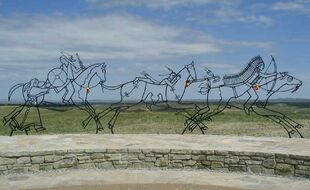Indigenous

Resolute, Nunavut
The Resolute Moment was erected in 2010 to commemorate the Inuit who were exiled from their land by the federal government and forcibly relocated to the High Arctic in the 1950s. This monument, made of stone, depicts a lone man gazing out to the ocean at the location of the High Arctic where Inuits had arrived by ship.

Darke County, Ohio
This memorial commemorates the Treaty of Greenville (1795) between the US and the indegenous peoples of Northwest territory (namely the Wyandot and Deleware peoples) which marked the end of a battle in Ohio during the 1930s between American army headed by Anthony Wade seized Native Americans led by the Blue Jacket of the Shawnee. The Native American signatories of this treaty agreed the cede their land south and east of the Cuyahoga River and the US would cede claims of land north and west of that territory. The Native Americans were also given $20,000 worth of goods for singing the treaty.

Red Lake County, Minnesota
Erected in 1932, this monument commemorates the treaty in which the Chippewa Indians ceded their rights to the Red River Valley in Minnesota to the US. The Treaty of Old Crossing (1863) was a forced treaty in order to serve the business interests of the local and national government. This treaty allowed for businesses, most notably transportation companies, to pass through the Chippewa territory (specifically the Pembina Trails) and compensated Chippewa by allocating $20,000 per year for 20 years and $100,000 per year to each "Indian Trader." In addition, the treaty entailed that 160 acres of land will be granted to each Chippewa "male adult half-breed or mix blood... who has adopted the habits and customs of civilized life."



Little Bighorn
Located on the battlegrounds of Little Bighorn, however, this monument was not recognized until 1997. Before, the battleground was made to remember the American troops in the battle but was later changed to remember Native American lives.
